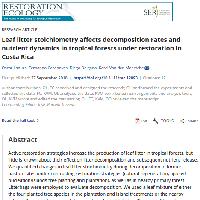Resumen
-
Active restoration strategies increase the production of leaf litter in tropical forests, but little is known about their effect on litter decomposition and subsequent nutrient release. We quantified changes in leaf litter stoichiometry during decomposition in former pasture sites under contrasting restoration strategies (natural regeneration, applied nucleation/islands tree planting and plantation), as well as in nearby primary forest. Litterbags were employed to evaluate decomposition. We used a leaf mixture of either the four planted tree species in the plantation and island treatments or the nearby primary forest and compared them under a factorial design. Decomposition rates were similar between restoration treatments (p > 0.5), but leaves decomposed faster in the forest mixture than in the plantation mixture (p < 0.01). The content of Ca, Mg, K, P, and the C:N ratio were higher in the forest mixture at the beginning and during decomposition (p < 0.05); the N content in the plantation mixture was higher at the beginning but lower during decomposition (p < 0.05), which meant greater mobilization of nitrogen per unit of carbon lost. K and P had a strong initial release, while Mg was released more gradually. N and Ca had an irregular pattern of initial fast release, immobilization, and re-release in the later stages. We conclude that the differences in rates of decomposition and nutrient release in these systems under restoration were at least partly determined by the floristic heterogeneity and chemical quality of the leaf litter that reaches the soil
